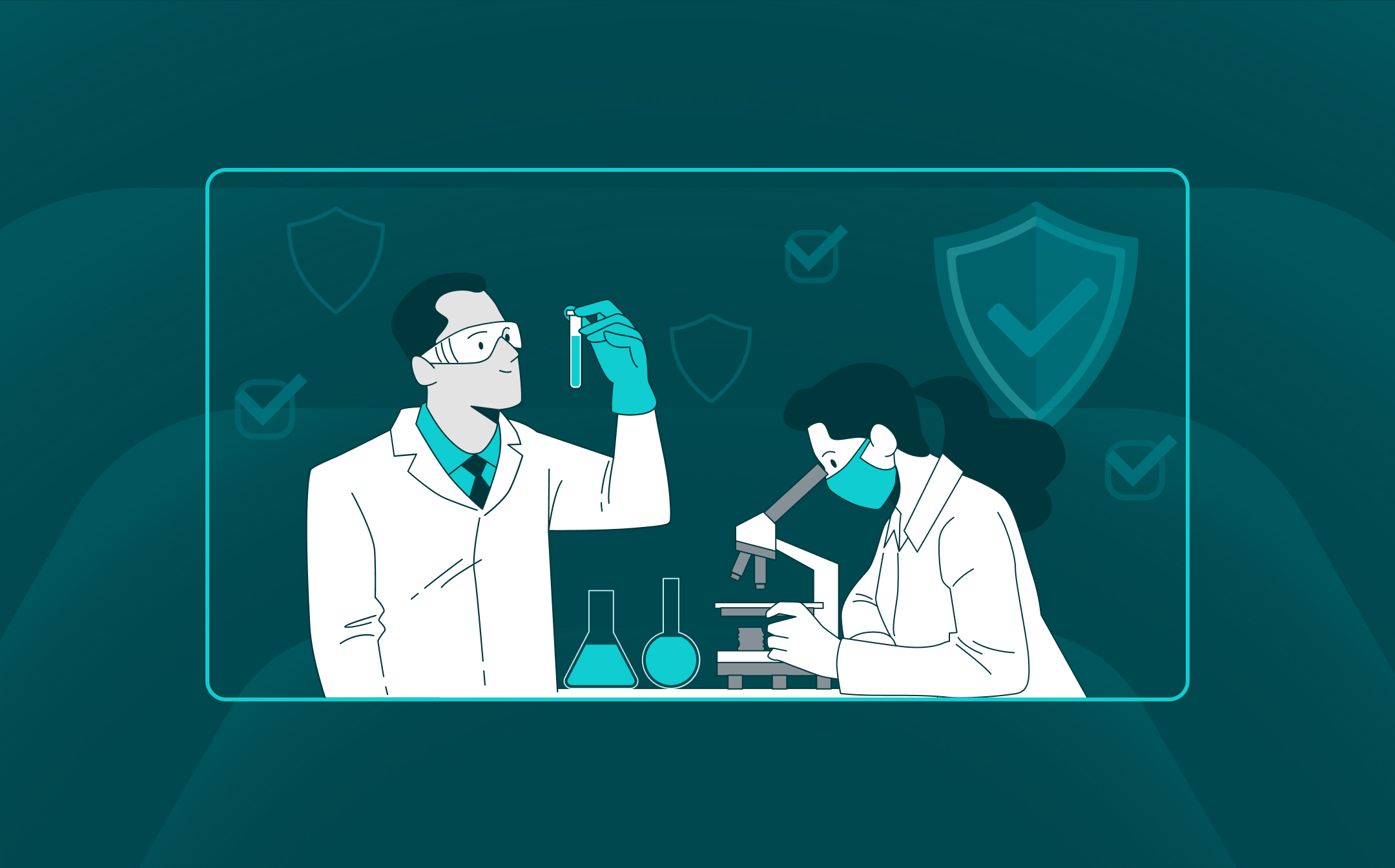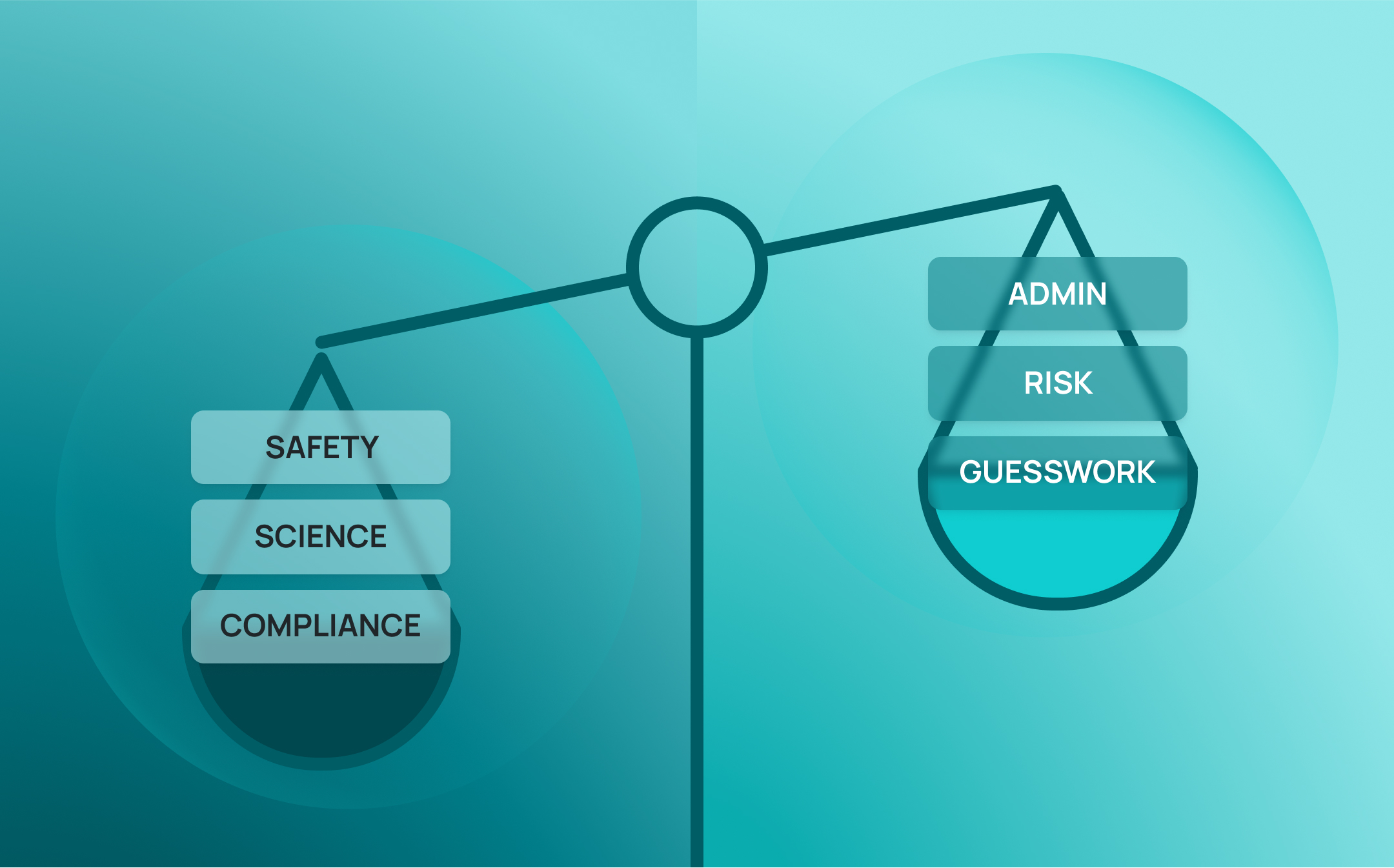Digital Tools for Safer and More Sustainable Life Science Labs
Learn how digital tools, like Scientific Management Platforms (SMPs) enhance safety, sustainability, and efficiency in life science labs.

Download Whitepaper
If you manage environmental health and/or safety (EHS) in a life science laboratory, you can set up safety protocols, and put up eye-spray stations that you test daily, but building a culture of compliance is a whole other can of worms. Furthermore, the link between EHS and sustainability efforts are not always top-of-mind for lab personnel.
So, how can you educate and compel researchers to be more sustainable?
In the modern lab, where digitalization continues to make research more efficient and streamlined, leveraging software platforms that centralize lab operations – including EHS and sustainability efforts – can help you avoid safety and sustainability mistakes that can cost millions of dollars and could lead to personnel injuries.
In this article, we’ll cover EHS in the life sciences, its link to sustainability, how to enforce compliance digitally, leveraging tools such as ELN/LIMS, and the best practices for achieving this. Using a decentralized platform for EHS and other lab operations is a mistake you do not want to make, so we also introduce a new type of software tool for laboratories called a Scientific Management Platform (SMP), that combines EHS (especially Exposure Control), with your day-to-day ELN/LIMS.
Environment, Health, and Safety (EHS) in Life Sciences and Biotech
What is EHS?
EHS in life sciences and biotech involves policies and procedures designed to:
- Protect the environment from biohazards and chemical pollutants.
- Ensure employee health through safe practices and exposure controls.
- Maintain workplace safety in laboratories, manufacturing, and research facilities.
EHS Areas of Focus
Environmental Protection
- Waste Management: Disposal of biohazardous and chemical waste following strict guidelines.
- Energy Efficiency: Implementation of green lab initiatives to reduce energy use.
- Sustainable Practices: Incorporating biodegradable materials and reducing water use in lab operations.
Occupational Health
- Exposure Control: Limiting exposure to pathogens, hazardous chemicals, and radiation.
- Health Monitoring: Regular health screenings for employees working with toxic substances.
- Mental Well-being: Programs addressing stress in high-pressure research environments.
Workplace Safety
- Equipment Safety: Regular maintenance of autoclaves, centrifuges, and lab machinery.
- PPE Compliance: Ensuring the use of lab coats, gloves, goggles, and respirators where necessary.
- Emergency Readiness: Spill response training and protocols for accidents involving biological or chemical agents.
Top 10 EHS Examples in Life Sciences and Biotech
Academic and industry labs handle hazardous materials, dangerous equipment, and harmful biological agents. Effective EHS programs ensure compliance to mitigate the risks of these activities. Below are ten examples that highlight essential safety measures in these high-risk settings.
- Biowaste Management: Segregation and sterilization of biological waste.
- Fume Hood Usage: Safe handling of volatile chemicals and reagents.
- Pathogen Containment: Use of biosafety cabinets for handling infectious agents.
- Radiation Safety: Monitoring and control for radiological materials in research.
- Chemical Inventory Systems: Tracking and proper storage of hazardous substances
- Ventilation Systems: Preventing air contamination in laboratories.
- Incident Reporting: Documenting and analyzing lab accidents and near misses.
- Ergonomic Lab Design: Preventing repetitive strain injuries among researchers.
- Hazard Communication: Clear labeling and documentation of chemical and biological hazards.
- Training Programs: Regular EHS training tailored to biotech-specific risks.
Real-World Applications of EHS
The examples above apply to various sectors within the industry, from R&D to large-scale manufacturing.
- Pharmaceutical R&D: Safely handling toxic reagents and ensuring GMP compliance.
- Biomanufacturing: Managing emissions and waste from large-scale bioreactors.
- Clinical Trials: Protecting researchers from potential pathogen exposure during specimen handling.
- Gene Therapy Labs: Strict protocols for handling genetically modified organisms (GMOs).
Benefits of EHS in Life Sciences and Biotech
By tailoring EHS practices to the unique challenges of life sciences and biotech, organizations can achieve safer and more compliant operations while driving innovation. The benefits of EHS compliance include:
- Ensures regulatory compliance (e.g., OSHA, WHO, IFC).
- Reduces environmental impact of high-tech lab activities.
- Enhances employee safety and operational efficiency.
- Builds public trust by prioritizing ethical and sustainable practices.
What is the Link Between EHS and Sustainability?
EHS provides a foundation for a laboratory or organizations sustainability practices, by mitigating the environmental impacts of research, ensuring worker safety, and promoting efficient use of resources. In this context, sustainability refers to the adoption of business practices that meet present needs without compromising the ability of future generations to meet theirs. It involves integrating environmental stewardship, social responsibility, and economic viability to achieve long-term success.
EHS Integration with Sustainability:
- Energy Use Reduction: Transitioning to energy-efficient lab equipment.
- Carbon Neutral Labs: Offsetting carbon emissions from lab processes.
- Water Recycling: Using closed-loop systems in biomanufacturing.
Sustainability Through Digitization: The Role of a Scientific Management Platform (SMP) in Labs and Institutions
Introduction to Lab Sustainability through Digitization
Sustainability in labs and research institutions extends beyond environmental conservation; it encompasses efficient resource use, minimizing waste, and adopting practices that ensure long-term viability.
Digitization, particularly through the adoption of Electronic Lab Notebooks (ELNs), Laboratory Information Management Systems (LIMS), or all-in-one SMPs plays a pivotal role in driving sustainability by reducing physical resource dependence and enhancing operational efficiency.
What is an SMP?
An SMP is a digital ecosystem that unifies lab operations, digital research, and EHS. It’s distinguished from other ELN and LIMS platforms in that it is a single platform that serves the needs of an entire life science organization, including scientists, lab operations professionals, EHS and compliance personnel, and leadership.
Impact of an SMP on Lab Sustainability
1. Reduction of Paper and Physical Resource Use
- Traditional Practices: Labs have historically relied on paper-based lab notebooks, forms, and records, leading to significant paper waste.
- Digitized Solution: SMPs, as well as ELNs and LIMS, eliminate the need for physical notebooks and documentation, significantly reducing paper usage. A large institution can save thousands of sheets of paper annually by transitioning to digital systems.
2. Streamlining Data Management
- Resource Optimization: SMPs, ELNs, and LIMS centralize data storage, eliminating redundancies and enhancing accessibility, thereby reducing the energy costs associated with manual data retrieval and storage.
- Cloud Integration: Many systems operate on energy-efficient cloud platforms, further reducing on-site energy consumption.
3. Decreasing Redundancy and Waste
- Inventory Control: SMPs and LIMS improve inventory management, ensuring efficient use of reagents and consumables, reducing overstocking, and minimizing expired materials.
- Experimentation Efficiency: SMPs and ELNs support accurate experiment tracking, preventing redundant trials and saving time and resources.
4. Energy Efficiency in Lab Operations
- Digitally Monitored Systems: SMPs and LIMS can integrate with lab equipment to optimize energy usage, such as monitoring freezers, incubators, and other devices.
- Scheduling and Maintenance: These platforms help schedule equipment usage and maintenance, reducing unnecessary energy consumption.
5. Waste Management and Compliance
- Traceability: LIMS and SMPs enhance the traceability of samples and reagents, ensuring proper disposal of hazardous materials and compliance with environmental regulations.
- Analytics: The analytics modules in these systems can identify wasteful practices and recommend more sustainable workflows.
6. Remote Collaboration and Access
- Virtual Collaboration: SMPs and ELNs enable remote data sharing and collaboration, reducing the need for physical presence and associated travel, contributing to lower carbon footprints.
- Global Integration: Institutions can collaborate globally without duplicating experiments or resources.
Impact of an SMP on Institutional Sustainability
1. Institution-Wide Standardization
Digital systems promote uniformity across labs, ensuring sustainable practices are maintained at every level. Standardization also enables new personnel to quickly and easily adopt standardized practices during onboarding.
2. Educational and Training Benefits
Digital platforms make sustainability training more effective by integrating real-time data tracking and eco-conscious decision-making.
3. Long-Term Cost Efficiency
Though initial implementation costs are high, digitization reduces operational costs in the long term by minimizing resource wastage and improving process efficiency.
4. Scalability and Growth
Digitized labs are better equipped to scale sustainably as they require fewer physical expansions and utilize resources more efficiently.
Impact of an SMP on Global Sustainability
1. Alignment with SDGs
Digitized labs contribute to the United Nations’ Sustainable Development Goals (SDGs) by promoting responsible consumption and production (Goal 12) and climate action (Goal 13).
2. Carbon Footprint Reduction
Digitally driven labs contribute to global carbon reduction efforts through energy efficiency, reduced paper use, and waste minimization.
3. Circular Economy Participation
By optimizing resources and ensuring traceability, labs using ELNs and LIMS align with the principles of a circular economy.
Driving Safety and Sustainability Through Lab Digitalization
Digital tools, like SMPs, are transforming life science labs and organizations by enhancing safety, sustainability, and efficiency. As EHS initiatives align with sustainability goals, platforms like ELNs, LIMS, and SMPs streamline compliance, reduce waste, and optimize operations.
SMPs, in particular, centralize lab management, ensuring resource efficiency, data traceability, and proactive safety measures. By embracing digital transformation, labs can foster a culture of sustainability, minimize environmental impact, and enhance operational excellence, positioning themselves for long-term success in an evolving scientific landscape.
To learn more about SMPs and their role in lab safety and sustainability, contact us.
Read more of our blogs about modern lab management
Discover the latest in lab operations, from sample management to AI innovations, designed to enhance efficiency and drive scientific breakthroughs.





